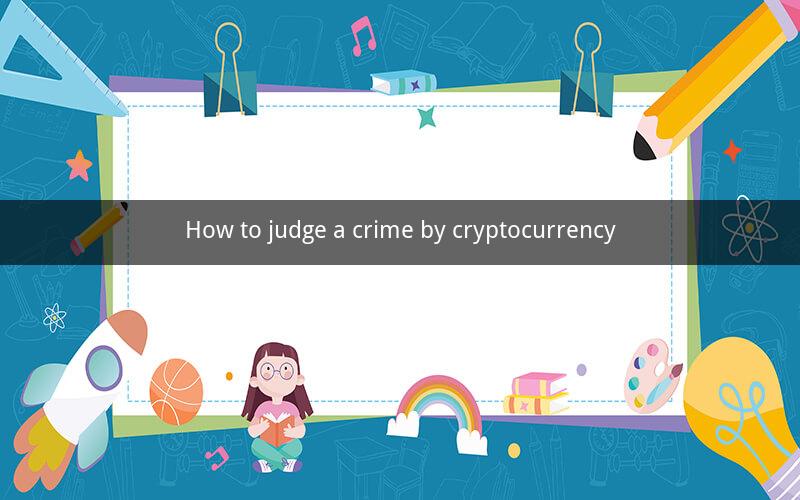
How to Judge a Crime by Cryptocurrency
Table of Contents
1. Introduction to Cryptocurrency
2. The Role of Cryptocurrency in Crime
3. Identifying Illicit Activities
4. Analyzing Transactions
5. Utilizing Blockchain Forensics
6. Collaborating with Law Enforcement
7. The Challenges of Investigating Cryptocurrency-Related Crimes
8. Conclusion
1. Introduction to Cryptocurrency
Cryptocurrency, a digital or virtual form of currency, has gained significant traction in recent years. Its decentralized nature, lack of a central authority, and the ability to conduct transactions without intermediaries have made it an attractive tool for both legitimate and illicit activities. Understanding the basics of cryptocurrency is crucial in evaluating its role in criminal activities.
2. The Role of Cryptocurrency in Crime
The anonymity and pseudonymity provided by cryptocurrency have made it a preferred choice for criminals. It is often used for money laundering, financing terrorism, drug trafficking, and other illegal activities. The ability to transfer funds quickly and across borders without detection has facilitated these crimes.
3. Identifying Illicit Activities
Detecting cryptocurrency-related crimes requires a keen eye for suspicious activities. These may include:
- Unusually large transactions
- Frequent transactions to and from known dark web marketplaces
- Activity patterns that deviate from typical user behavior
- The use of mixing services to obfuscate the origin of funds
4. Analyzing Transactions
Analyzing cryptocurrency transactions is a crucial step in identifying potential criminal activities. By examining the blockchain, investigators can track the flow of funds and identify suspicious patterns. Key factors to consider include:
- The transaction size and frequency
- The addresses involved in the transaction
- The use of private and public keys
- The timestamps of the transactions
5. Utilizing Blockchain Forensics
Blockchain forensics is a specialized field that focuses on the analysis of blockchain data to uncover criminal activities. This involves:
- Extracting relevant data from the blockchain
- Analyzing the data to identify patterns and anomalies
- Correlating the findings with other information sources
6. Collaborating with Law Enforcement
Effective investigation of cryptocurrency-related crimes requires collaboration between law enforcement agencies and experts in the field. This collaboration can include:
- Sharing information and resources
- Coordinating investigations
- Training law enforcement personnel on cryptocurrency and blockchain technology
7. The Challenges of Investigating Cryptocurrency-Related Crimes
Investigating cryptocurrency-related crimes presents several challenges:
- The complexity of blockchain technology
- The difficulty in tracing funds due to the decentralized nature of cryptocurrencies
- The rapid evolution of the cryptocurrency landscape
- The international nature of many cryptocurrency-related crimes
8. Conclusion
Cryptocurrency has become an indispensable tool for both legitimate and illicit activities. Understanding how to judge a crime by cryptocurrency is essential for law enforcement agencies and cybersecurity professionals. By analyzing transactions, utilizing blockchain forensics, and collaborating with law enforcement, it is possible to uncover and investigate cryptocurrency-related crimes.
Questions and Answers
1. Q: What is cryptocurrency?
A: Cryptocurrency is a digital or virtual form of currency that uses cryptography to secure transactions and control the creation of new units.
2. Q: How can cryptocurrency be used for money laundering?
A: Cryptocurrency can be used for money laundering by transferring funds to and from multiple addresses, making it difficult to trace the original source of the funds.
3. Q: What is blockchain forensics?
A: Blockchain forensics is the analysis of blockchain data to uncover criminal activities, such as money laundering and financing terrorism.
4. Q: How can law enforcement agencies collaborate with experts in the field?
A: Law enforcement agencies can collaborate with experts by sharing information and resources, coordinating investigations, and training personnel on cryptocurrency and blockchain technology.
5. Q: What are some challenges in investigating cryptocurrency-related crimes?
A: Challenges include the complexity of blockchain technology, the difficulty in tracing funds, the rapid evolution of the cryptocurrency landscape, and the international nature of many cryptocurrency-related crimes.
6. Q: Can cryptocurrency transactions be traced?
A: While cryptocurrency transactions are pseudonymous, they can be traced to some extent through blockchain analysis and collaboration with exchanges and other service providers.
7. Q: How can individuals protect themselves from cryptocurrency-related scams?
A: Individuals can protect themselves by conducting thorough research before investing in cryptocurrencies, using secure wallets, and being cautious of unsolicited investment opportunities.
8. Q: What is a dark web marketplace?
A: A dark web marketplace is an online platform where illegal goods and services, including drugs, firearms, and counterfeit goods, are sold.
9. Q: How can mixing services be used to obfuscate the origin of funds?
A: Mixing services combine cryptocurrency transactions from multiple users, making it difficult to trace the original source of the funds.
10. Q: What is the role of blockchain in preventing crime?
A: Blockchain can prevent crime by providing a transparent and immutable record of transactions, making it easier to detect and investigate fraudulent activities.